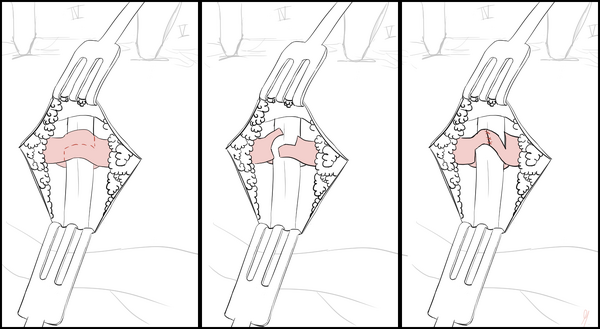Scaly finger
Trigger finger is a common cause of pain and dysfunction in the hand area. Scaly finger in adults is the result of nodular thickening of the tendon sheath of the flexor accompanied by stenosis of the 1st annular loop at the level of the metacarpophalangeal joint. Initially, there is a limitation, later a complete inability to move the flexor tendon of the finger. It occurs most often in middle-aged women and affects IV, III. finger and thumb. The cause is mostly unknown, but it can occur in rheumatic , diabetic and dialysis patients.
Clinical picture[edit | edit source]
The patient presents with peeling (jumping of the tendon) or blockage of the finger during flexion or extension. In the initial stages, there is pain when reaching full flexion + crepitation, later "finger snapping". Although the patient often localizes the problem to the interphalangeal joint, palpation tenderness and skipping (movement of the thickened tendon) is on the palm over the A1 loop.
Therapy[edit | edit source]
The first method is conservative therapy , during which stenosing tendovaginitis can disappear spontaneously. We can also use an extension splint at night or spray the tendon sheath in the place where the loop passes with a corticoid with a local anesthetic . The success rate for spraying is 60-70%. It is necessary to avoid application directly to the tendon due to the risk of rupture.
Another option is surgical therapy , which is used when conservative therapy fails. During the operation, the tendon sheath of the finger flexor is opened so that the tendon can move freely. Surgical release of the A1 loop under local anesthesia is applied.
Scaly thumb[edit | edit source]
Trigger thumb is more common in young children than in adults. Adults lack the reactive components of inflammation. Painless flexion deformity of the interphalangeal joint (pain and "skipping" during extension).
Therapy : passive stretching of the thumb flexor tendon, night splint, possibly surgical (usually only in the 4th year of the child).
Links[edit | edit source]
Related Articles[edit | edit source]
References[edit | edit source]
- BOWDEN, Gavin, Gavin BOWDEN and Simon THOMAS, et al. Oxford handbook of orthopedics and trauma. 1st edition. Oxford: Oxford university press, 2010. ISBN 978-0198569589 .
- DUNGLE, P., et al. Orthopedics. 1st edition. Prague: Grada Publishing, 2005. ISBN 80-247-0550-8 .

